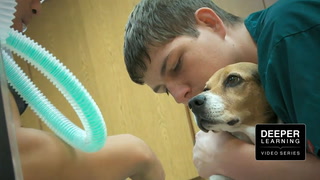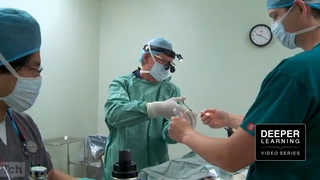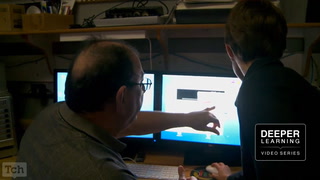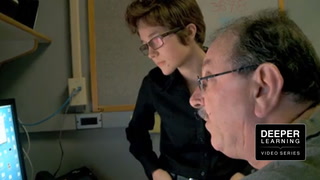Kathleen Cushman on Student Internships Transcript
Card: Tch Teaching Channel
In Partnership with The William and Flora Hewlett Foundation
Card: Big Picture Learning
Expert Commentary by:
Kathleen Cushman
Lower Third: Kathleen Cushman
WKCD.org
Author, "The Motivation Equation"
+++ 00:00:11 +++
Kathleen Cushman: My name is Kathleen Cushman, and I've been documenting the learning of adolescents for over 25 years. What's really interesting about Big Picture, it's really all about developing agency, and these young adults are inhabiting a world of adults when they go out on these internships. Now this doesn't happen very much in adolescence. In fact, the research about adolescence, sociological research says adolescents tend to more and more be segregated in a
+++ 00:00:37 +++
world of their own, with other adolescents. It used to happen in the days of apprenticeship, and the wonderful thing that Big Picture has brought back is that notion of apprenticeship, of craft developing over the years in the context, as Elliot Washer [ph?] says so well of, "Being with people who do things well, and talking with those people, and doing things with those people." And it really creates, number one, stretch; number two, reflection on how you're doing
+++ 00:01:07 +++
and what you're doing; and number three, the all-important condition of planning your next steps. Because pretty much in everything that these Big Pictures students are doing, they are-- they're stretching themselves, but they're also thinking back on it, self-assessing, and they're planning what to do next. And what's really fascinating to me in my own research over the last four years or more with what kids can do is I'm thinking about adolescent
+++ 00:01:36 +++
motivation and mastery. People talk about mastery as if it were a done deal. But it's actually not. It's a journey. And anybody who's ever tried to do something difficult, knows that it's a continuing journey, even for the people who really-- we can consider masters at their craft or art or profession. Deeper learning is 360 degrees learning, all the way around a student. You need to get all parts of a student involved if
+++ 00:02:06 +++
it's going to be deep. And that's clearly happening with these Big Picture things. I mean, here is the young man who, in order to get to his possible career of being a vet-- which so many students want to do-- first, started out working in a doggy-daycare. Okay, so what did he learn there? Well, he learned how to pick up a dog, he said. We saw him picking up a dog who had been anesthetized. That didn't come just in
+++ 00:02:36 +++
that first moment. So he's getting it in his body in a way. If you can't really do something, then it has to happen somewhere in you that you can take something that you know and really do it. You can see the students here who are working in different fields, like the young woman who works in television. Okay, she obviously came in with a really sharp curiosity and really dying to do that thing. But there were a lot of things that she didn't know how to do. And they
+++ 00:03:07 +++
required her to think hard, and she herself says that she-- that, "Self-assessing is no easy task." So she started learning-- somebody who clearly had been pretty successful in the past, started learning how to critique her own performance. That was a really piece-- that was a big piece of deep learning for her. These aren't just easy internships that they get handed and go out once a week on, or less, and get a taste of the
+++ 00:03:39 +++
world. This-- they have to learn things that they've-- first of all, before they even make a call, they have to know something about what they're calling about. They have to learn to do research. Then they have to learn to do the hardest thing in the world, which is making a cold-call to somebody. Then they have to go in be humble, and realize that they don't know anything, and are really ignorant. That's a huge piece of deeper learning, and then bit-by-bit, they have to assemble the kinds of knowledge, information and skill
+++ 00:04:10 +++
that they will need, and then transfer it into new situations. And really what we're asking in the Common Core Anchor standards is to grow into a really thoughtful adult. And you can look at any one of those Common Core standards, in math or in English/Language Arts across the disciplines ,and you can see the things that are happening at Big Picture. Perseverance is big in Common Core. Precision, revision, self-
+++ 00:04:41 +++
assessment, critique. All those things show up in those Anchor standards. How can it not result in deeper learning outcomes? It is the heart and soul of deeper learning outcomes!
Card: Tch Teaching Channel
In Partnership with The William and Flora Hewlett Foundation
#### End of CUSH_BPTS.m4v ####













0 Comment